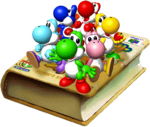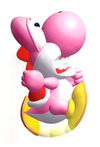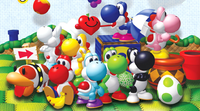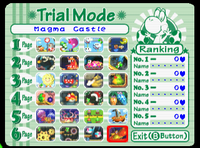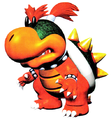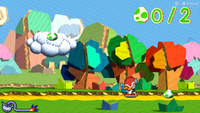Yoshi's Story
- This article is about the Nintendo 64 game. For other uses, see Yoshi's Story (disambiguation).
| Yoshi's Story | |||||||||||||
|---|---|---|---|---|---|---|---|---|---|---|---|---|---|
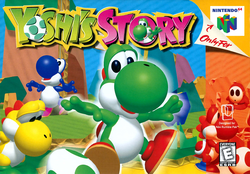 For alternate box art, see the related gallery. | |||||||||||||
| Developer | Nintendo EAD | ||||||||||||
| Publisher | Nintendo | ||||||||||||
| Platforms | Nintendo 64, iQue Player, Virtual Console (Wii, Wii U), Nintendo 64 - Nintendo Classics | ||||||||||||
| Release dates | Nintendo 64: iQue Player: Virtual Console (Wii): Virtual Console (Wii U): Nintendo 64 - Nintendo Classics: | ||||||||||||
| Languages | English Japanese Chinese (Simplified) French (France) German | ||||||||||||
| Genre | Platformer | ||||||||||||
| Ratings |
| ||||||||||||
| Mode | Single player | ||||||||||||
| Format | Nintendo 64:
iQue Player:
Wii: Wii U: Nintendo Switch: | ||||||||||||
| Input | Nintendo 64: iQue Player: Wii: Wii U: Nintendo Switch: | ||||||||||||
| Serial codes | |||||||||||||
Yoshi's Story is a 2D sprite-based platform game in the Yoshi franchise, and the first one outside the Yoshi's Island series, released for the Nintendo 64. It was released in 1997 in Japan and two months later in 1998 in the United States. Later, it received a port to the Wii's Virtual Console in fall of 2007 for all regions and the Wii U's Virtual Console in early 2016, and it is one of the launch titles for Nintendo 64 - Nintendo Classics. The music of Yoshi's Story was composed by Kazumi Totaka, who voices Yoshi in this game, a first for the Super Mario franchise. The gameplay possesses similar mechanics to the Yoshi's Island series of games, but it does not include Baby Mario.
A tech demo called Yoshi Demo was unveiled at the time of the Game Boy Advance's first announcement. The title was seemingly either a port or a direct sequel to Yoshi's Story, but it is unknown if it was simply meant as a demo or was canceled. Years later, a title called Yoshi Topsy-Turvy was released, and it featured the same art style and mechanics as Yoshi's Story and was perceived as a sequel. Yoshi's Story was also the first Super Mario/Yoshi game on the Nintendo 64 released in North America to be rated E for "Everyone" due to the changeover by the ESRB from the previously used K–A for "Kids to Adults" rating in 1998.
Story[edit]
If the player waits for about nine seconds on the title screen, the book onscreen opens and tells this story:
Out of the blue, the island fell, darkened by an evil spell.
The blink of an eye was all it took and the island became a storybook.
The Super Happy Tree vanished, too, and once-happy Yoshis began to stew.
Only Baby Bowser could be so mean, to ruin the happy Yoshis' dream.
The Island[sic] had paid an awful cost, for the Super Happy Tree was lost.
Elsewhere on the pop-up isle, some Yoshi eggs survived the trial.
The spotted eggs in that Yoshi nest would soon face Baby Bowser's test.
One by one, they began to hatch. Six little Yoshis--a perfect batch!
They scratched their heads and looked around. Some even tried to pound the ground.
Sadness darkened every Yoshi's face. It should've been a Super Happy place.
They quickly saw the problem at hand required a cunning Yoshi plan.
"If we grow Super Happy," the Yoshis thought, "we'll spoil Bowser's evil plot."
Their mission then was crystal clear. They had to go and spread the cheer!
So it was, they all agreed, to rescue the Super Happy Tree.
They set out to follow the trail of fruit to find where the tree had taken root.
One Yoshi wondered, as he bounced, if Baby Bowser could be trounced.
"We'll stay together," the others cried[sic] "and stomp his Baby Bowser hide."
By eating fruit and having fun, the deed would surely soon be done.
And so the Yoshis' quest began, to find the tree and save the land.
Just turn the page and you will see how happiness grows in a tree.
Yoshis live in harmony on Yoshi's Island, and their ultimate source of happiness is provided by the Super Happy Tree. Baby Bowser becomes jealous of their happiness and steals the Super Happy Tree, crushing their happiness, and then performs a spell to turn the entire island into a pop-up picture book.
Six Baby Yoshis hatch on the island and learn of what Baby Bowser has done, and thus, they set out to retrieve the tree. They venture through six "pages" of the island, until eventually fighting him at the end and retrieving the Super Happy Tree.
Gameplay[edit]
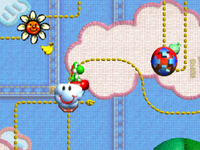
Yoshi's Story is played much like Super Mario World 2: Yoshi's Island, although a few aspects were tweaked or removed, such as the timer that counted down for Baby Mario when a Yoshi was hit and a Yoshi's ability to morph. To complete a level, the Baby Yoshis have to eat exactly 30 fruits scattered through the level. Before starting a level, the player has to select a Baby Yoshi. Each Yoshi has different taste when it comes to fruits and Shy Guys, and it recovers more health (and scores more points) if it eats a fruit or a Shy Guy that is of its own color. The top left corner of the screen has a flower that serves as the life bar called the Smile Meter; the flower's petals fall off as a Yoshi loses health, and its facial expression also changes accordingly (happy when full, sad when dying). Certain characters aid the Yoshis in various ways, including Miss Warps, who can teleport the Yoshis to different parts of the level, and Poochy, who can find hidden objects from far away.
If a Baby Yoshi is defeated within the level, that Baby Yoshi is taken to the castle of Baby Bowser[13] by Baby Bowser's Toadies. If all of the Baby Yoshis are kidnapped, the game is over. However, any lost Baby Yoshi (aside from the secret, unlockable Black and White Yoshis) can be saved by finding a White Shy Guy and finishing the level with it. When the player starts a game in either Story Mode or Trial Mode, the game randomly selects a Lucky Fruit. Said Lucky Fruit automatically heals all of a Yoshi's life, even if the Yoshi is not supposed to like the fruit.
Each world has four different levels to choose from; once a level is beaten, the player moves on to the next world without visiting the other three levels. This means to play through every single level, the player must play through the game at least four different times, going to the unvisited levels in each world. The game has four difficulty levels: Novice, Easy, Medium, and Hard.
Yoshis' moves[edit]
The Baby Yoshis can perform various moves to complete their adventure. Most of these moves were taken from Yoshi's Island, although some were tweaked or now have a new function.
Jumping and fluttering[edit]
By pressing ![]() , the player can make a Yoshi jump; by pressing
, the player can make a Yoshi jump; by pressing ![]() again and holding it, the player can make a Yoshi flutter-jump. This helps the player get to higher places. It is possible to flutter longer by holding
again and holding it, the player can make a Yoshi flutter-jump. This helps the player get to higher places. It is possible to flutter longer by holding ![]() after a Yoshi grunts. While fluttering, a Yoshi can do so even higher if the player presses Up on the Control Stick.
after a Yoshi grunts. While fluttering, a Yoshi can do so even higher if the player presses Up on the Control Stick.
Swallowing[edit]
To swallow an object, the Baby Yoshis have to lick with their tongues. It is possible to control the direction of the tongue with the Control Stick. Unlike in Yoshi's Island, a Yoshi automatically ingests the things he eats with his tongue.
Throwing eggs[edit]
When a Yoshi eats an enemy, it can turn into an egg. A Yoshi can aim the egg he made at various things when the player presses and holds ![]() or
or ![]() , and he can throw it when the player releases the button. If the player wants to cancel throwing an egg, they should push
, and he can throw it when the player releases the button. If the player wants to cancel throwing an egg, they should push ![]() . Eggs can also be thrown to collect coins and Special Hearts. Even if a thrown egg does not hit anything, it explodes where the cursor was placed, and any enemies or bubbles in the explosion can be defeated or popped, respectively. The explosion's size changes depending on how happy the Yoshi is, although an egg thrown by the Black Yoshi or White Yoshi has more of an explosive impact. Black-spotted eggs explode only when the Black Yoshi or White Yoshi throws them. A thrown egg might simply fall offscreen after hitting some targets, such as bosses, Bumper Balls, or weights. Thrown eggs can also ricochet off walls. Eggs cannot be thrown underwater, however.
. Eggs can also be thrown to collect coins and Special Hearts. Even if a thrown egg does not hit anything, it explodes where the cursor was placed, and any enemies or bubbles in the explosion can be defeated or popped, respectively. The explosion's size changes depending on how happy the Yoshi is, although an egg thrown by the Black Yoshi or White Yoshi has more of an explosive impact. Black-spotted eggs explode only when the Black Yoshi or White Yoshi throws them. A thrown egg might simply fall offscreen after hitting some targets, such as bosses, Bumper Balls, or weights. Thrown eggs can also ricochet off walls. Eggs cannot be thrown underwater, however.
Ground Pound[edit]
For a Baby Yoshi to utilize this move, the player must jump and quickly press Down on the Control Stick. The Yoshi pounds the ground. A Ground Pound can be used to reveal a few items hidden in the ground or to defeat enemies.
Sniffing[edit]
Being a move exclusive to this game, sniffing is helpful in finding objects hidden in the ground. To execute it, the player must press . If a Baby Yoshi is near an object, a "!" will appear next to the Baby Yoshi's head. If the Baby Yoshi is standing on a hidden item, he will wave at the player. Any objects hidden in the ground can be revealed by ground-pounding them. If a hidden item is in midair or in a rock block, the Baby Yoshi might need to throw an egg at the hidden item's spot to reveal it. In a few levels, the player can find Poochy, who sniffs for the Yoshi clan.
Modes[edit]
Story Mode[edit]
As the main portion of the game, Story Mode contains 24 levels (four per world), but only six can be played during a single playthrough (the game jumps directly to the next world after a level is completed). The player can choose which of the four levels on the first page they wish to start on. However, the choice of levels in later worlds is determined by the number of Special Hearts collected in the previous level. To finish each level, the Yoshis must eat 30 different fruits scattered throughout the level. Whenever a level is completed, the Baby Yoshis start singing and a text appears to explain what happened in the level.
Trial Mode[edit]
Trial Mode is a mode that allows the player to play any stage that they have beaten in Story Mode. In order to unlock all the stages, the player must play Story Mode at least four times and get all the Special Hearts from the stage that they were playing. This mode was created to save the player's highest score of the levels. To quit a stage, the ![]() and
and ![]() buttons should be pressed together. Also, the player cannot use the Black Yoshi or White Yoshi; both are playable only in Story Mode.
buttons should be pressed together. Also, the player cannot use the Black Yoshi or White Yoshi; both are playable only in Story Mode.
Eating nothing but melons is the most efficient method of increasing one's high score, although it can be difficult to perform in some stages. If this is done, a marker appears at the end of the level. In order to eat all the melons from the stage, the player needs to sniff all the time to find hidden objects in the ground.
Also, if the player waits for two minutes and ten seconds, "Totakeke's theme" is heard.
Practice[edit]
- Main article: Practice
The Practice mode consists of an exclusive level in which the various controls and techniques of the game are explained. This level is the only one that does not have 30 melons in it.
Worlds and levels[edit]
| Levels | |||||
|---|---|---|---|---|---|
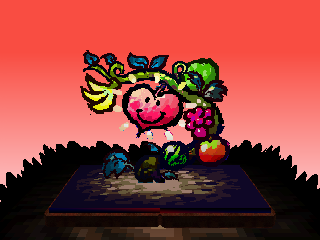
| |||||
| Icon | # | Level | Type of level | ||
| N/A | N/A | Practice | Plains | ||
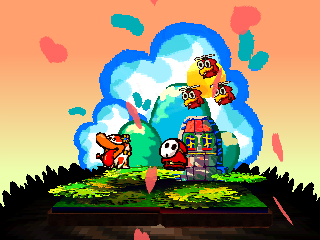
| |||||
| Icon | # | Level | Type of level | ||
| 1-1 | Treasure Hunt | Plains | |||
| 1-2 | Surprise!! | Coast | |||
| 1-3 | Rail Lift | Coast | |||
| 1-4 | Tower Climb | Tower | |||
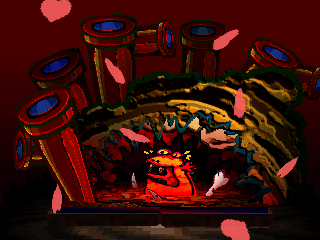
| |||||
| Icon | # | Level | Type of level | ||
| 2-1 | Bone Dragon Pit | Cave | |||
| 2-2 | Blargg's Boiler | Lava Coast | |||
| 2-3 | Jelly Pipe | Sewer Cave | |||
| 2-4 | Torrential Maze | Sewer | |||

| |||||
| Icon | # | Level | Type of level | ||
| 3-1 | Cloud Cruising | Coast | |||
| 3-2 | The Tall Tower | Tower | |||
| 3-3 | Poochy & Nippy | Snow | |||
| 3-4 | Frustration | Snow Sewer | |||

| |||||
| Icon | # | Level | Type of level | ||
| 4-1 | Jungle Hut | Village | |||
| 4-2 | Jungle Puddle | Swamp | |||
| 4-3 | Piranha Grove | Brambles | |||
| 4-4 | Neuron Jungle | Swamp | |||
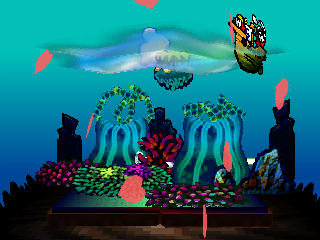
| |||||
| Icon | # | Level | Type of level | ||
| 5-1 | Lots O'Jelly Fish | Coast Underwater | |||
| 5-2 | Lots O'Fish | Coast Underwater | |||
| 5-3 | Shy Guy Limbo | Plains | |||
| 5-4 | Shy Guy's Ship | Coast | |||
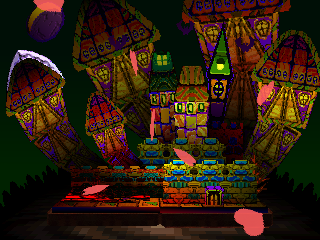
| |||||
| Icon | # | Level | Type of level | ||
| 6-1 | Mecha Castle | Castle | |||
| 6-2 | Lift Castle | Castle Tower | |||
| 6-3 | Ghost Castle | Castle Cave | |||
| 6-4 | Magma Castle | Lava Castle Cave | |||
Characters[edit]
Playable[edit]
All the following Yoshis are playable. Each of their names is listed next to their Favorite Fruit. When a Yoshi eats one of its favorite foods, the Smile Meter heals more than it usually does. Eating melons also has this effect, no matter which Yoshi color it is. The different colors also serve as lives. The Black Yoshi is unlocked after the player finds a hidden black-spotted Giant Egg in the Bone Dragon Pit or Torrential Maze, and the White Yoshi is unlocked after the player finds a hidden white Giant Egg in The Tall Tower or Poochy & Nippy.
| Yoshis | Favorite Fruit |
|---|---|
| All | |
Supporting characters[edit]
| Image | Name | Description |
|---|---|---|
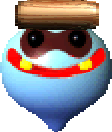 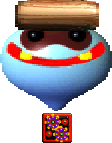
|
Balloon Bully | A balloon-like entity that carries a log on its head, allowing the Yoshis to reach otherwise inaccessible locations. |
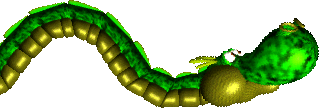 
|
Dragon | A serpentine creature that acts as a lift for the Yoshis to use while in the air or over lava. |
| Ghost Rider | A whisp-like spirit that acts as a platform for the Yoshis to use. | |

|
Ghost Stream | A squishy ghost that acts as a platform Yoshis can climb on. |
| Huffin Puffin | Wanders around with chicks following. The chicks can be used as replacements for eggs. | |
| Lakitu | Rewards Yoshis with melons depending on their performance in certain minigames. | |
| Miss Warp | An egg-shaped creature that is asleep, but soon warps Yoshis to another Miss Warp when awoken. | |
| Neuron | A slug-like creature that makes movements depending on its color. | |
| Poochy | A dog that can sniff items for the Yoshis. He follows a Yoshi. | |
| Power Bee | An insect that restores health to the Yoshis when eaten. These creatures cannot harm the Yoshis if touched. | |
 
|
Snake | A serpentine creature that acts similarly to a dragon, except it is much smaller. |
| White Shy Guy | A friendly Shy Guy that can rescue any captured Yoshi if a level is completed after one is found. |
Enemies[edit]
| Image | Name | Description | First appearance | Last appearance |
|---|---|---|---|---|

|
Air Bag | A balloon creature that appears from an immovable Mystery Crate. It attacks by blowing air at a Yoshi. | Surprise!! | |

|
Attacky Sack | A circular marble-like creature that bounces around aimlessly, attempting to run into a Yoshi. | Magma Castle | |
| Bamboo dancers | Two Shy Guys that each hold a long stick across a pathway, requiring the Yoshi to jump over it. | Shy Guy Limbo | ||
|
Bee | A swarm of bees inhabits a hive and obstructs the Yoshi's path if the Yoshi moves too quickly near them. If the Yoshi hits the bees with an egg, they will attack the Yoshi. | Jungle Hut | Lots O'Fish |
| Big & Little Boo | A line of Boos that follow each other, holding a melon within the line. They mimic the reverse of a Yoshi's movements. | Jelly Pipe | ||
| Black Shy Guy | An aggressive version of Flying Shy Guy. | Poochy & Nippy | Ghost Castle | |
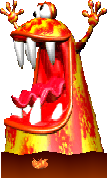
|
Blargg | A giant blob-like creature that randomly arises from lava. | Blargg's Boiler | |
| Blindfold Boo | A blindfolded Boo that uses sound cues such as the gathering of coins to attack a Yoshi. | Ghost Castle | ||

|
Blue Blurp | A giant fish that spits water up at Yoshis. If a Yoshi falls into the river the Blurp resides in, the Yoshi will be eaten by it. | Jungle Puddle | |
| Bob-bomb | A sentient bomb that wanders around, eventually exploding. Any Yoshis caught in the blast take damage. | Shy Guy's Ship | ||
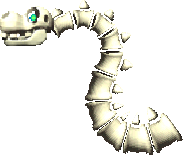
|
Bone Dragon | A head of the Bone Dragon that is separated from the main body. | Bone Dragon Pit | |
| Boo | A ghost enemy that stops moving when looked at and follows a Yoshi when facing away. It can be defeated only by looking away from it and bouncing an egg off a wall to hit it. | Ghost Castle | ||
| Block Boo | A Boo that disguises as a block when looked at. It reveals its true form when looked away from. | Ghost Castle | ||
| Bullet Bill | A bullet-like enemy that is emitted from a Turtle Cannon and travels in a straight line. | Tower Climb | Shy Guy's Ship | |
| Bumblebee | A big bee that flies ahead in a straight line, grouped from both sides of the screen. | Cloud Cruising | ||
| Bumpty | A penguin-like foe that can bump a Yoshi around. | Frustration | ||
| Burner Heihō | A Shy Guy that pushes around a flaming urn, releasing flames that trap Yoshis in between. | Magma Castle | ||
| Centipede | An enemy with spiked segments that paces around intersections. | Frustration | ||
| Cheep Cheep | A fish that swims around, either in a straight line or in a set pattern. | Neuron Jungle | Lots O'Fish | |
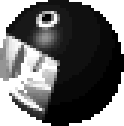
|
Chomp | A dog-like enemy that constantly chomps forward. | Jungle Hut | |
| Clam | An aquatic creature that blows bubbles, propelling a Yoshi upwards into ceilings and sea cacti. | Lots O'Fish | ||
| ComBat | A bat-like enemy that flies in place and attacks any Yoshi that gets too close, and are resistant to non-egg attacks. | The Tall Tower | Magma Castle | |
| Do-Drop | A drop of water that drops down from a cloud. | Jelly Pipe | Shy Guy Limbo | |
| Flying Shy Guy | An airborne Shy Guy that carries a fruit. If a Yoshi eats the fruit, the enemy flies away. Flying Shy Guys without fruit appear in a group of four; if a Yoshi defeats all four with a single egg, that Yoshi is awarded a melon. Tiny ones appear in large swarms, with only some holding fruit. | Practice (red) Practice (yellow) Tower Climb (green) Blargg's Boiler (blue) Poochy & Nippy (quartet) Cloud Cruising (mini) |
Magma Castle (red) Magma Castle (yellow) Mecha Castle (green) Mecha Castle (blue) Shy Guy Limbo (quartet) Lots O'Jelly Fish (mini) | |
| Frog | An amphibious enemy that jumps around. | Neuron Jungle | ||

|
Fuzzy Wiggler | A caterpillar enemy that wanders around endlessly. It can be defeated only if a Yoshi turns all of its segments purple. | Surprise!! | |
| Gabon | A small Koopa enemy that coughs up and throws large spike balls. | Jungle Hut | ||

|
Ghost | One of Baby Bowser's pets, which he rides in his battle and uses to block eggs. | Mecha Castle | Magma Castle |
| Goonie | A bird that flies around and can be ridden on. Some Goonies carry bombs. These creatures cannot directly harm a Yoshi if touched. | Poochy & Nippy | Shy Guy's Ship | |
| Ick Worm | A worm that floats down on a leaf. If the worm is eaten, a Yoshi will lose health (except for the Blue Yoshi). | Neuron Jungle | ||
| Jelly Ghost | A Boo that resides in jelly, lashing out at any Yoshi that comes near. | Jelly Pipe | Torrential Maze (transparent) Jelly Pipe (solid) | |
  
|
Jellyfish | A sea creature that has multiple behaviors depending on its color. Some jellyfish actively chase a Yoshi, while others stay in one place. | Lots O'Jelly Fish | |
| Lakitu | A cloud-riding turtle enemy that chases its opponents while throwing various items. | Bone Dragon Pit | Shy Guy Limbo | |
| Lava Ghost | An elongated Spark Spook that jumps out in an arced fashion. | Blargg's Boiler | ||
| Little Boo | A miniature Boo that swoops down at Yoshis if provoked. | Ghost Castle | ||
| Mr. Eel | An eel that swims mindlessly in a straight pattern. | Jungle Puddle | Lots O'Fish | |
| Nipper Plant | An enemy that appears after a Nipper Spore has touched the ground. | Bone Dragon Pit | ||
| Nipper Spore | A free-flying dandelion-like enemy that becomes a Nipper Plant after it touches the ground. Eating it does not produce an egg, instead hurting any Yoshi (except for the Black and White ones). | Bone Dragon Pit | ||

|
Pak E. Derm | An elephant that holds up a stop sign in an attempt to block a Yoshi's progress. He can be temporarily stunned with a Ground Pound. | Treasure Hunt | |
| Para-bomb | A parachute-wearing Bob-bomb dropped by Baby Bowser. | Mecha Castle | Magma Castle | |
| Peeper | A bird that flies around. If a Yoshi shoots one with an egg, it will lose its feathers and fall down. | The Tall Tower | Frustration | |

|
Piranha Plant | A plant enemy that grows on a vine, attempting to ensnare a Yoshi by bending towards them. | Piranha Grove | |

|
Piranha Pest | A Piranha Plant sprout that attempts to swallow a Yoshi with its long tongue. A swallowed Yoshi temporarily shrinks. | Piranha Grove | |
| Piranha Sprout | A small Piranha Plant that stands low on the ground in an attempt to eat a Yoshi. | Piranha Grove | ||
| Puffer | An elephant-like creature that releases balls of energy. | Blargg's Boiler | Magma Castle | |
| Raven | A black bird enemy that is found wandering around platforms. | The Tall Tower | ||

|
Red Blurp | A giant Cheep Cheep that jumps out of the water in an attempt to eat a Yoshi. | Jungle Puddle | |
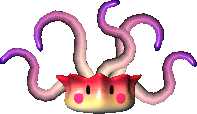
|
Sea Anemone | A sea creature that reaches out towards a Yoshi with its long arms. | Lots O'Fish | |
| Sea cactus | A spiked Neuron of varying sizes and colors that can be found wriggling from side to side near or under water. | Neuron Jungle | Lots O'Fish | |
| Sensuikan Heihō | A Shy Guy that pilots a submarine, shooting torpedoes at any intruders. | Lots O'Jelly Fish | ||
| Shy Guy | A mask-wearing enemy that is the ubiquitous enemy in the game. Shy Guys wander about, come in different colors, and can be defeated in any manner. | Practice (red) Practice (yellow) Treasure Hunt (green) Practice (blue) |
Magma Castle (red) Lift Castle (yellow) Magma Castle (green) Lift Castle (blue) | |
| Shy Guy On Stilts | A Shy Guy that walks around on stilts. | Jungle Hut (red, short) Jungle Hut (red, medium) Rail Lift (yellow, short) Rail Lift (yellow, medium) Rail Lift (yellow, tall) Rail Lift (green, short) Rail Lift (green, medium) Shy Guy's Ship (green, tall) Rail Lift (blue, short) Jungle Hut (blue, medium) |
Shy Guy's Ship (red, short) Shy Guy's Ship (red, medium) Lots O'Fish (yellow, short) Rail Lift (yellow, medium) Rail Lift (yellow, tall) Rail Lift (green, short) Shy Guy's Ship (green, medium) Shy Guy's Ship (green, tall) Shy Guy's Ship (blue, short) Shy Guy's Ship (blue, medium) | |
| Shy Guys on Pogo Sticks | Shy Guys that bounce around on pogo sticks. | Surprise!! (red) Surprise!! (yellow) Surprise!! (green) Jungle Hut (blue) |
Rail Lift (red) Shy Guy Limbo (yellow) Jungle Hut (green) Shy Guy Limbo (blue) | |
| Snow Guy | A Shy Guy dressed in winter attire, throwing snowballs at any Yoshi it sees. | Poochy & Nippy | Frustration | |
| Spark Spook | A fireball that jumps up and down out of lava. | Blargg's Boiler | Magma Castle | |
| Spider | An arachnid-like enemy that attacks a Yoshi by dangling from a string. | Surprise!! | Jungle Hut | |
| Spike | A metallic enemy that jumps around or straight up in the air. | Bone Dragon Pit | Magma Castle | |
| Spiked Fun Guy | An enemy that jumps from the background, before suddenly rolling down any slopes it lands on. | Jelly Pipe | Torrential Maze | |
| Spiny Fish | A spined Cheep Cheep that causes a Yoshi to take damage if eaten. | Lots O'Jelly Fish | Lots O'Fish | |
| Tehee Butterfly | A butterfly that flashes between pink and blue. If a Yoshi eats a blue one, the Yoshi will lose some of its health. | Rail Lift | Shy Guy Limbo | |
| Toady | Toadies appear when a Yoshi faints, carrying them off to Baby Bowser's castle. They also appear after Baby Bowser's battle to carry him out of his castle. | When a Yoshi gets a Game Over, and after Baby Bowser is defeated. | ||

|
Wweight | A giant Thwomp-like object dropped by a Black Shy Guy. | Mecha Castle | Ghost Castle |
| Vine Slime | A slug-like enemy that climbs up and down a vine. Vine Slimes appear only in the international versions of the game. | Torrential Maze | ||
Mini-bosses[edit]
| Image | Name | Description |
|---|---|---|
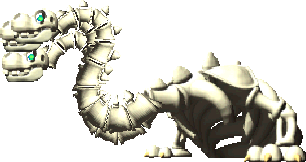
|
Bone Dragon | A three-headed skeletal dragon that shoots flames. The Yoshis must defeat each head either by throwing two eggs at each head or by ground-pounding each head two times. |

|
Slug | A giant colorful creature that can be defeated only by making eggs pop near its eyes. |
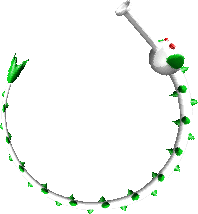
|
Snorkel Snake | A gigantic eel that attempts to encircle a Yoshi. Despite being treated as a mini-boss, it cannot be defeated; instead, the Cheep Cheeps in its lair must be defeated while the Yoshi avoids it. |
Bosses[edit]
| Image | Name | Description |
|---|---|---|
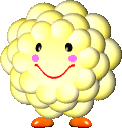
|
Cloud N. Candy | A Cloud boss that can be gradually eaten by a Yoshi. The boss is defeated when she is entirely eaten. |

|
Inviso | A ghost that remains invisible while releasing Peepers to attack. A Yoshi must hit him with three eggs to defeat him. |
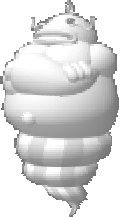
|
Cloudjin | A giant, wind-bending genie that floats around. Hitting his stomach with three eggs (while he is tangible) defeats him. |
| Don Bongo | A giant Gabon-like creature that creates earthquakes with each step. A Yoshi must shoot three eggs at his lips to defeat him. | |

|
Baby Bowser | As the final boss, Baby Bowser first rides around on his pet while throwing bombs. Said bombs must be sent back to damage him. Afterwards, the remainder of the battle is on foot. |
Obstacles[edit]
| Image | Name | Description | First appearance | Last appearance |
|---|---|---|---|---|
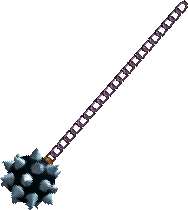
|
Ball 'N' Chain | A swinging spiked iron ball that damages Yoshis on contact. | The Tall Tower | Magma Castle |

|
Ball and chain | A windup Ball 'N' Chain that slams the ground instead of swinging. | The Tall Tower | Magma Castle |
| Beehive | A bee nest that must be passed slowly to avoid disturbing the bees. | Jungle Hut | Lots O'Fish | |
 
|
Bocci Ball | A giant ball that rolls when stood upon. Larger ones spin in the air without moving. | Blargg's Boiler | Piranha Grove |
| Bumper Ball | A bouncy obstacle that travels along rails. | Rail Lift | Lift Castle | |

|
Buzz saw | A whirring saw blade that appears moving on rails or stationary in walls. | Mecha Castle | Magma Castle |

|
Chain Gate | A door that can be raised by cranking a nearby swing. | Mecha Castle | |

|
Jelly | A viscous substance that can be ground-pounded to briefly dent it. | Jelly Pipe | |
| Lava fall | A torrent of magma that falls and travels along the floor, damaging Yoshis on contact. | Magma Castle | ||

|
Piston | A large mechanism that slams together, instantly defeating any Yoshi that gets crushed. | Mecha Castle | |
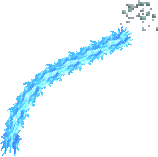
|
Rushing water | A torrent of water that falls and travels along the floor, pushing Yoshis on contact. | Torrential Maze | |

|
Shy Guy Galleon | A ship manned by Shy Guy pirates that remains in the background, shooting various items at Yoshis. | Shy Guy's Ship | |
| Spiked ball | A heavy iron ball that falls or rolls. | Poochy & Nippy | Shy Guy Limbo | |
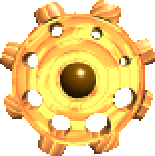 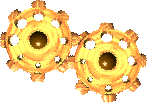
|
Sprocket | A rolling platform that either constantly spins or spins only in response to a Yoshi's movements and position. | Mecha Castle | |
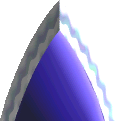 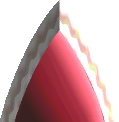
|
Sword | A giant blade that emerges from a floor, wall, or ceiling. | Mecha Castle | |
 
|
Turtle Cannon | Shoots an endless supply of Bullet Bills to the side, straight up, or towards nearby Yoshis. | Tower Climb (horizontal) Tower Climb (vertical) Shy Guy's Ship (following) |
Shy Guy's Ship |
Items[edit]
| Image | Name | Description |
|---|---|---|
| Bob-bomb | Bob-bombs can be collected by licking them, after which they can be thrown, much like Yoshi eggs. | |
| Bomb Berry | An explosive spiked fruit that tastes horrible to Yoshis (except the Black and White Yoshis). It slowly grows, drops, and regrows endlessly. | |
| Bumber 'Chute | An umbrella that helps a Yoshi glide to places. | |
| Coin | Coins are found throughout the levels; they exist only for scoring purposes, though collecting all in an area sometimes leads to melons. | |
| Coin (hopping) | Coins with feet spawn in sets of five for a short period and always give a melon when all are collected. | |
| Fruit | Various kinds of fruit appear, the most prominent being the melon, appearing 30 times in every level. | |
| Giant Egg | A hidden egg that unlocks a secret Yoshi if found and brought to the stage's end. | |
| Heart Fruit | A fruit that makes a Yoshi Super Happy when eaten. | |
| Key | Keys are required to open locked doors. They can be obtained by defeating certain enemies or popping a certain ? Bubble. One key is out in the open. Keys can be used only one time each. | |
| Melon crate | The focus of Special Delivery, where a stack of seven must be brought to the finish without being dropped. | |
| Pepper | A spicy fruit that only the Black and White Yoshis can stand the taste of but is not included in the level's fruit tally regardless. | |
| Power Flower | A flower that restores a Yoshi's health when eaten. | |

|
Special Heart | An item that unlocks a level in Story Mode. Three Special Hearts can be found in each level. |
| Tulip | A flower that transforms a Yoshi into an egg to reach high and seemingly inaccessible places. | |
| Yoshi egg | A Yoshi's primary weapon. |
Objects[edit]
| Image | Name | Description |
|---|---|---|
| ? Block | A block that, when hit from below, initiates one of three melon-related minigames (Catch the Coins, the Melon Race, or Broad Jump) or releases a coin with each hit, with the eleventh hit turning the block into a melon. | |
| ? Bubble | ? Bubbles contain various objects and occasionally enemies. | |
| ? Switch | An object that causes a variety of events. | |
| Arrow Sign | Points to other rooms offscreen or other areas of interest. | |
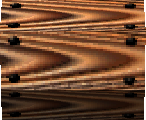
|
Bolt Lift | A large platform that rotates when stood upon. |
| Bomb | A small explosive dropped by certain enemies. | |
| Bubble | A common floating object containing a fruit. | |
| Bucket | A large washtub used as a makeshift boat. It can be moved by tilting it. | |

|
Cloud | A stationary platform that appears in various sizes. |
| Cloud Puffer | A mechanism that sprays strong gusts. | |
| Conveyor Belt | A floor that moves objects that are on it. | |
| Delay Switch | An object that extends the time of a ? Switch event when hit with an egg. | |

|
Door | An entrance to another room. |
| Egg Block | A block that gives a Yoshi up to six eggs when hit from below. In Western releases, its spots are the same color as the Yoshi the player plays as. | |

|
Falling spike | A spike on the ceiling of Baby Bowser's room. Hitting falling spikes with a projectile makes them fall and can damage him. |
| Flag | Marks the starting and ending points of melon challenges. | |
| Flatbed Ferry | A floating platform that behaves in various ways. | |
| Flatbed Ferry generator | Pushes out or pulls in a line of Flatbed Ferries. | |
| Flowerpot | Starts the Special Delivery challenge when ground-pounded. | |
| Lakitu's Cloud | A floating platform that can be ridden and controlled for a short period when the Lakitu is evicted. | |
| Leaf | Can be surfed on through the air for a short period. | |
| Lever | Changes the direction of rails when hit. | |
| Lift | A simple elevator that moves vertically. | |
 
|
Locked door | A door that can be opened only once the player uses a key, which unlocks it for the remainder of a stage. |
| Message Block | A block that gives help and information when a Yoshi jumps and hits it from below. | |
| Mystery Crate | A crate that contains a hidden item, sometimes an Air Bag. | |

|
Pipe | An object that transports a Yoshi to another part of a level when entered. |
| Post | Keeps Poochy chained until ground-pounded. | |
| Propeller Lift | An object that allows a Yoshi to fly up on it. If it hits the ground, a wall, or a ceiling, it disappears. | |
| Rail Lift | A Cloud Block that travels along a rail. | |
| Rock block | A type of block that comes in blue and yellow. Blue rock blocks can be destroyed with eggs, while yellow rock blocks cannot be destroyed at all. | |
| Seesaw | A platform that tilts when something heavy is on one side. | |

|
Sinking bone | A giant femur that sinks into lava when stood upon. |

|
Spring | An object on a wall that comes in three sizes and can be bounced on. |
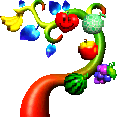
|
Super Happy Tree | The main focus of the game. It was stolen by Baby Bowser and supplies a limited amount of fruit in the battle against him. |
| Surprise Ball | An object that allows a Yoshi to reach higher ground by licking it. | |

|
Swing | A platform that activates a Chain Gate when swung. |
| Vase | A jar that transports a Yoshi to another part of a level when entered. | |
| Vine | A dangling plant that can be climbed and swung from. Vines appear only in international releases. | |
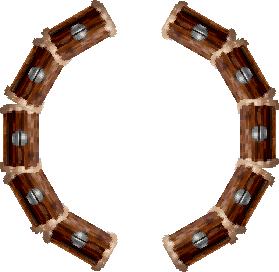
|
Wheel lift | A huge wheel that moves across a gap when spun inside. |
Regional differences[edit]
- All Baby Yoshis have the same vocal range used for the Green and Yellow Yoshis in the Japanese version only.
- In the Japanese version, the color of the spots on Egg Blocks is green regardless of the color Yoshi being used. In international releases, the Egg Block spot color matches that of the Yoshi being used.
- Cloudjin flashes red when hurt in the Japanese version only.
- When data is erased in the Japanese version, an explosion can be heard. In the international version, it plays a fanfare.
- In the Japanese version, the intro is written in a rainbow pastel font, whilst international releases use a normal font colored with a two-toned gradient.
- In the international localizations, eating 30 of the same fruit shows an image of said fruit instead of a heart on the "Level Complete" screen. In the Japanese version, only the heart is used.
- It is not possible to save a Story Mode game in the Japanese version.
- In the NTSC version, the game is able to switch between Japanese and English text. In the PAL version, the Japanese option was replaced with German and French.
- The international version cancels all momentum when the player eats a fruit on the ground.
- Blargg's Boiler has two bubbled melons above the second-to-last bone bridge. In the international version, only one is found there.[14]
- Only the international versions of Shy Guy Limbo contain a music track for the sections where Bamboo Dancers appear.[15]
- In the fight with Baby Bowser, the Yoshis start slightly farther away from him in the Japanese version.
- The European version contains an additional sound effect on the Game Over screen.[16]
- Some of the Ghost Stream sections were replaced with Vine Slimes in the Japanese version.
- The international version adds secret coin formations that spell letters to every level, triggered when a heart fruit is eaten by Yoshi. These were entirely absent in the Japanese version.
- The Japanese version has a glitch that can allow the player to play any level from the first world in the Practice Mode. In international versions, this glitch was fixed.
Pre-release and unused content[edit]
- Main article: List of Yoshi's Story pre-release and unused content
The game was first revealed in Shoshinkai 1996 as Yoshi's Island 64. The early logo looks similar to the SNES game Super Mario World 2: Yoshi's Island logo, implying that Yoshi's Story was originally planned as a sequel to said game, be more complex, and would have been a title in the Yoshi's Island series. However, after the health meter was chosen, the game was considered the first platformer in the Yoshi franchise outside of the Yoshi's Island series for Nintendo consoles.[citation needed]
Reception[edit]
| Reviews | |||
|---|---|---|---|
| Release | Reviewer, Publication | Score | Comment |
| N64 | Peer Schneider, IGN | 7/10 | "Story will most definitely sell many many copies based on the reputation of its predecessor. But there will be a lot of unhappy gamers once they discover that Nintendo's mantra seems to have changed to Quality over Quantity of Levels. Trust us: You'll love it when you rent the game, but don't buy it. You'll finish it in a weekend -- but don't quit playing until you have seen the fourth level on each page..." |
| N64 | Joe Fielder, GameSpot | 5.3/10 | "Yoshi's Story doesn't provide lots of motivation to make you want to pull this off or really even play the game for more than 20 minutes. After a while, you realize it's the same trick over and over: find a piece of fruit, find a heart, find a piece of fruit, find a heart. Altogether, it's just not a lot of fun. The slight changes that Nintendo made to the game from the Japanese version (such as an unnoticeable increase in difficulty and the addition of letters that you must collect for the best ending) didn't really seem to improve the title at all. In the end, Yoshi's Story is good for a rental at best." |
| N64 | Jonathan Bee, Nintendo Life | 6/10 | "Yoshi's Story tells a bare-bones story against a brilliantly colourful backdrop, utilizing some novel platforming mechanics to bolster interest but ultimately falling a little flat in execution. It doesn't approach the level of its classic predecessor on the SNES, but fans of the series might want to take a visit to relive those days of yore. It's lighthearted fare and pleasant enough — just make sure to hold your expectations in check." |
| Aggregators | |||
| Compiler | Platform / Score | ||
| Metacritic | 65 | ||
| GameRankings | 59.91% | ||
Sales[edit]
The game sold 1.28 million copies in the Americas and 2.85 million worldwide.
Staff[edit]
- Main article: List of Yoshi's Story staff
Yoshi's Story was directed by Hideki Konno, who previously served as the director of Super Mario World 2: Yoshi's Island. Kazumi Totaka served as the sound composer and voice actor of the Yoshis and Shy Guys. This game marks the first time Totaka voices Yoshi. Takashi Tezuka served as the producer, Shigeru Miyamoto served as the supervisor, and Hiroshi Yamauchi served as the excutive producer.
Gallery[edit]
- For this subject's image gallery, see Gallery:Yoshi's Story.
Soundtrack[edit]
The entire soundtrack was composed by Kazumi Totaka. Albums for the game's music was released in Japan, North America, and Europe, each with their own unique tracklist. Yoshi Story Original Soundtrack was released in Japan, Music to Pound the Ground to: Yoshi's Story Game Soundtrack was released in North America, and Love, Peace & Happiness: The Original Yoshi's Story Soundtrack was released in Europe. On June 24, 2025, the soundtrack was made available in its entirety on the Nintendo Music app.
Multimedia[edit]
- For the complete list of media files for this subject, see Multimedia:Yoshi's Story.
| File info 0:30 |
| File info 0:20 |
| File info 0:29 |
| File info 0:29 |
| File info 0:20 |
Appearances in other media[edit]
Yoshi's Story was the subject of volumes 19 and 20 of Super Mario-kun.
Yoshi's Story was also featured in Club Nintendo's comics. These were later collected in a comic book titled Yoshi's Story Comic.
Volume 19 of Super Mario-kun
References to other games[edit]
- Yoshi's Story was originally to be called Yoshi's Island 64.
- Many of the elements from this game return in Yoshi's Story, and the two games share very similar gameplay.
- A small portion of the "Flower Garden" track can be heard 43 seconds into "Games of Happiness."
- Yoshi's sprites in Yoshi's Story use Yoshi's design from this game.
References in later media[edit]
- A stage called Yoshi's Island is based on Yoshi's Story.
- Some of Yoshi's moves and animations originate from Yoshi's Story.
- The Yoshi's Island stage from Super Smash Bros. returns, and a new one called Yoshi's Story is playable.
- The main way of keeping the Yoshis healthy in this game is by eating fruits.
- Yoshi's Island is turned into a storybook again.
- The Super Happy Tree appears in Yoshi Park.
- An arrangement of the ending theme from Yoshi's Story plays on the Yoshi's Island stage in both games.
- The same arrangement of the ending theme from Super Smash Bros. Brawl and the 3DS version as well as the arrangement used for the Yoshi's Story stage in Super Smash Bros. Melee play on the Woolly World stage, while the arrangement used for the Yoshi's Island stage in Super Smash Bros. plays on the Yoshi's Island stage.
- The Super Happy Tree can be found in Yoshi Park again.
- The park's music is an arrangement of "Yoshi's Song" and "Yoshi's Story."
- Rail Lift appears as the setting of the Dream Long Jump event.
- An arrangement of "Yoshi's Song" is used as the background music for this event.
- All the Yoshis from Yoshi's Story (including the unlockable Black and White Yoshis) are playable in the game.
- The Yoshis' Smile Meter reappears in the minigame Loves Me...?.
- The Yoshi Lake course is inspired by Yoshi's Story.
- Its music is an arrangement of the "Yoshi's Story" music track.
- The Yoshi's Fruit Cart attraction requires the player to collect fruits.
- All of the fruit from Yoshi's Story except for the Bomb Berry appear.
- An arrangement of "Yoshi's Song" plays in the daytime stages, and an arrangement of "Yoshi's Tale" plays in the nighttime stages.
- "Yoshi's Song" and "Yoshi's Tale" are included in the credits medley.
- Some of the elements from this game were borrowed from and inspired by Yoshi's Story, and it also stars Yoshi without Mario similarly to that game as well.
- The Yoshi's Story stage reappears, along with the Yoshi's Island stage from Super Smash Bros., renamed "Super Happy Tree."
- Don Bongo, Pak E. Derm, the Super Happy Tree, and Blargg appear as spirits, using their appearances from Yoshi's Story.
- A microgame based on Yoshi's Story is included.
- At the construction site are crates that have pictures of grapes and bananas on them, which resemble their depictions from this game. Later, watermelons with zigzag lines appear on a fruit stand, resembling the watermelons from this game.
- Wheel lifts return.
Names in other languages[edit]
| Language | Name | Meaning | Notes |
|---|---|---|---|
| Japanese | ヨッシーストーリー[17] Yosshī Sutōrī |
Yoshi Story | |
| Chinese | 耀西故事 (iQue, Simplified Chinese)[18] Yàoxī Gùshì |
Yoshi Story |
Notes[edit]
- In the North American version of Super Smash Bros. Brawl, the Chronicle erroneously states that Yoshi's Story was released on February 20, 1998, instead of March 9, 1998.
References[edit]
- ^ ヨッシーストーリー. Nintendo Co., Ltd. (Japanese). Retrieved May 11, 2023.
- ^ February 1998. Nintendo Power Volume 105. Nintendo of America (American English). Page 92.
- ^ Yoshi's Story official website. Nintendo of America (American English). Archived December 3, 1998, 06:59:25 UTC from the original via Wayback Machine. Retrieved June 22, 2024.
- ^ a b c Yoshi's Story. Nintendo of Europe (European French). Retrieved May 09, 2025.
- ^ Nintendo of America (September 23, 2021). Nintendo Direct - 9.23.2021 (21:00). YouTube (American English). Retrieved June 22, 2024.
- ^ Nintendo 公式チャンネル. Nintendo Direct 2021.9.24. YouTube (Japanese). Retrieved June 22, 2024.[dead link]
- ^ @NintendoEurope (September 23, 2021). Play a growing library of Nintendo 64 and SEGA Mega Drive games anytime, anywhere with #NintendoSwitchOnline + Expansion Pack, a new membership launching in late October.. X (British English). Retrieved June 22, 2024.
- ^ @NintendoAUNZ (September 24, 2021). Play a growing library of Nintendo 64 and SEGA Mega Drive games anytime, anywhere with #NintendoSwitchOnline + Expansion Pack, a new membership launching in late October.. X (Australian English). Retrieved June 22, 2024.
- ^ 《集合啦!動物森友會》將於11月5日發布免費更新(Ver.2.0),以及發售付費新增內容《集合啦!動物森友會 快樂家樂園》。. Nintendo HK (Traditional Chinese). Retrieved June 22, 2024.
- ^ 「Nintendo Switch Online」을 더욱 즐겁게! 「Nintendo Switch Online + 추가 팩」이 10월 26일(화)부터 시작!. Nintendo Korea (Korean). Retrieved June 22, 2024.
- ^ North American box cover
- ^ Official Website
- ^ 1998. Yoshi Story instruction booklet (PDF). Nintendo of Europe (English). Page 6.
- ^ The relevant sections from Unbaba no Sumutokoro and Blargg's Boiler
- ^ The relevant sections from Biba Banbūdansāzu and Shy Guy Limbo
- ^ Video of the sound effect.[dead link]
- ^ ヨッシーストーリー. nintendo.co.jp (Japanese). Retrieved June 22, 2024.
- ^ 耀西故事. iQue (Simplified Chinese). Retrieved June 22, 2024.
External links[edit]
- American English website
- British English website
- Japanese website
- Chinese website
- American English manual
- European manual (EN/FR)
- Japanese manual
| Nintendo 64 games | |
|---|---|
| Super Mario franchise | Super Mario 64† (1996) • Mario Kart 64† (1996) • Mario no Photopi (1998) • Mario Party (1998) • Mario Golf (1999) • Mario Artist: Paint Studio* (1999) • Mario Party 2 (1999) • Mario Artist: Talent Studio* (2000) • Mario Artist: Communication Kit* (2000) • Mario Tennis (2000) • Paper Mario† (2000) • Mario Artist: Polygon Studio* (2000) • Mario Party 3 (2000) • Dr. Mario 64† (2001) |
| Donkey Kong franchise | Diddy Kong Racing (1997) • Donkey Kong 64 (1999) |
| Yoshi franchise | Yoshi's Story† (1997) |
| Crossovers | Super Smash Bros.† (1999) |
